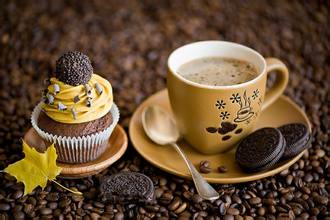Introduction to the Grinding degree of Highland Coffee Bean Arabica Price producing area characteristics, Flavor description treatment method
Arabica coffee beans
Coffee made from Arabica beans is of higher quality and tastes different than other commercially grown coffee varieties (such as Robusta), and the coffee contains less caffeine. The traditional processing method is to harvest coffee berries manually, peel them on the same day, and use manually selected coffee beans to be ground and boiled after baking. With fresh milk, do not use the general cream on the market, so the coffee is particularly smooth and rich. The specific features are:
1. The smell of fragrance is strong;
2. it's not easy to have a bitter taste.
3. The content of coffee oil is moderate;
4. High acidity
5. The caffeine content is 30% of Robusta's, 40% of Robusta's.
Although coffee shops are now full of variety, in the final analysis, there are only two kinds of artificial coffee, one is Arabica, the other is Coffea robusta (canephora), both of which are introduced from wild species. However, it has low resistance to drying, frost, diseases and insect pests, especially to leaf rust, the biggest natural enemy of coffee, so all producing countries are committed to improving varieties. For example, Sri Lanka, as we all know, used to be one of the most famous coffee producers in the past, but coffee farms were not spared by leaf rust at the end of the 19th century. Since then, Sri Lanka turned to the development of black tea, and was also the kingdom of black tea in India. At first, the commercial coffee in the world was all small-grain coffee, but at the end of the 19th century, there was a large-scale disease. Growers began to look for other disease-resistant varieties. In 2012, small-grain coffee was still the main coffee variety, accounting for about 3x4 of the world's total coffee production. Arabica coffee accounts for about 65% of the world's coffee beans. Coffee grown in Arabica accounts for 80% of the world's coffee beans. In 2012, it produced 48600 tons, with a total wholesale price of about $16 billion.

Important Notice :
前街咖啡 FrontStreet Coffee has moved to new addredd:
FrontStreet Coffee Address: 315,Donghua East Road,GuangZhou
Tel:020 38364473
- Prev

What do you call roasted coffee beans? introduction to the degree of coffee roasting technology
Coffee roasting is divided into the following degrees: first, very light roasting Light Roast coffee roasting technology the most mild roasting method, the beans are yellowish brown, aroma and concentration are mild light, can be used as the identification standard of the initial stage of roasting. Light baking / cinnamon baking Cinnamon Roast as the name suggests, the beans are cinnamon, slightly stronger in aroma and refreshing than very light baking.
- Next

Which countries grow coffee trees? how much fruit does a coffee tree have?
The fruit of coffee grown contains two seeds, namely coffee beans. The two beans are connected face to face with each other on one side of the plane. Each coffee bean has a thin outer film, which is called silver skin, and its outer layer is covered with a yellow outer skin, called endocarp. The whole coffee bean is wrapped in a sticky pulp to form a soft pulp.
Related
- Beginners will see the "Coffee pull flower" guide!
- What is the difference between ice blog purified milk and ordinary milk coffee?
- Why is the Philippines the largest producer of crops in Liberia?
- For coffee extraction, should the fine powder be retained?
- How does extracted espresso fill pressed powder? How much strength does it take to press the powder?
- How to make jasmine cold extract coffee? Is the jasmine + latte good?
- Will this little toy really make the coffee taste better? How does Lily Drip affect coffee extraction?
- Will the action of slapping the filter cup also affect coffee extraction?
- What's the difference between powder-to-water ratio and powder-to-liquid ratio?
- What is the Ethiopian local species? What does it have to do with Heirloom native species?

